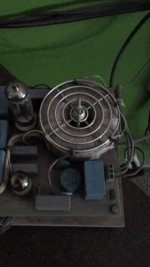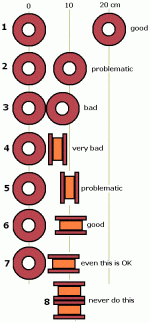I want to place the OPT directly above the main transformer. Both are toroidal. Rather than ask the question I setup a test. The two 6v3 windings in series of the mains transformer goes to a bridge and 40000uF of cap. Then on to a 40W 12V halogen bulb. The idea is to load the transformer and generate some rectifier harmonics similar to what would happen to the HT. The OPT is connected to a speaker.
Anyway the short of it is I don't hear a thing out of the speaker not even a squat with my ear right against it. So you can place the two right over each other.

Anyway the short of it is I don't hear a thing out of the speaker not even a squat with my ear right against it. So you can place the two right over each other.
It will depend on trafo design and construction. If the field strength B in the core is low (1T) perhaps the spread is sufficiently small to have negligible coupling. But if B is large (1.5T or more) or near saturation, the coupling may be larger. I disassemble to reuse lighting toros (12V 50Hz 50W) running near 1.35T.
Note 1Tesla = 10kGauss.
Note 1Tesla = 10kGauss.
Attachments
baudouin0 and Osvaldo de Banfield,
Thanks for the information!
You showed us a good test method so we can determine how good toroids are for rejecting fields, so we can do it ourselves.
"All Toroids are created equal, but some are more equal than others" - a very badly modified quote from George Orwell's "Animal Farm"
1 Tesla = 10k Gauss.
Is that at the center, or further to the left or right of the curve?
Keep up the good work!
Happy New Year!
Thanks for the information!
You showed us a good test method so we can determine how good toroids are for rejecting fields, so we can do it ourselves.
"All Toroids are created equal, but some are more equal than others" - a very badly modified quote from George Orwell's "Animal Farm"
1 Tesla = 10k Gauss.
Is that at the center, or further to the left or right of the curve?
Keep up the good work!
Happy New Year!
This is a unit conversion only. As I used the original primary but removed the 12V secondary to place mine new, counting the turns number and making some calculus, the induction was about 1.35T as already said.
About 500mV on the 2k2 primary. So about 25mV on the secondary. I do hear a quiet click from the speaker when I put the mains on.
In any case you can put a disk of alumimum or iron between them to improve decoupling. Iron short magnetic lines inside it while aluminum (or any other good conductor) create eddy current whos magnetic field try to counteract to the stray coupling.
Yep there's the steel plate between the two transformers so the nice OPT's are on the top with the power supply underneath. The GNFB will also reduce this too - so happy with the arrangement.
Mmmmmm in pic #1 you are showing toroids, the upper is clearly a toro. The bottom don't sure but also has face of toro.
I just went through the same exercise with an Antek toroid power transformer. A 0.6H Hammond EI choke connected to an oscilloscope was used as a probe to determine regions of minimum stray field. Minimum rectification pulses were picked up directly aligned with the outer rim. Aligned with the hole was bad, I recall worst case was 45 degrees between the two.
Osvaldo,
I tried to make a joke (pun).
You gave the helpful conversion factor for magnetic fields: From Tesla to Gauss.
My (joking) question was whether it was on the center, left, or right of the curve (Gaussian Probability Curve).
My joke was probably out-of-bounds (pun again). I am somewhat Eccentric.
Those two Gaussian items are related by the name Gauss, the only basis of the joke.
Happy New Year!
I tried to make a joke (pun).
You gave the helpful conversion factor for magnetic fields: From Tesla to Gauss.
My (joking) question was whether it was on the center, left, or right of the curve (Gaussian Probability Curve).
My joke was probably out-of-bounds (pun again). I am somewhat Eccentric.
Those two Gaussian items are related by the name Gauss, the only basis of the joke.
Happy New Year!
- Home
- Amplifiers
- Tubes / Valves
- Toroidal OPT mains transformer coupling


